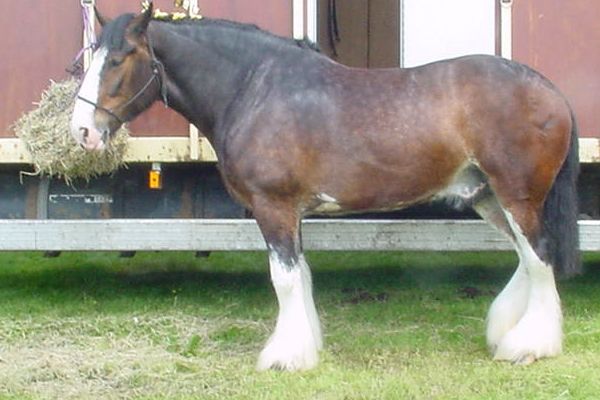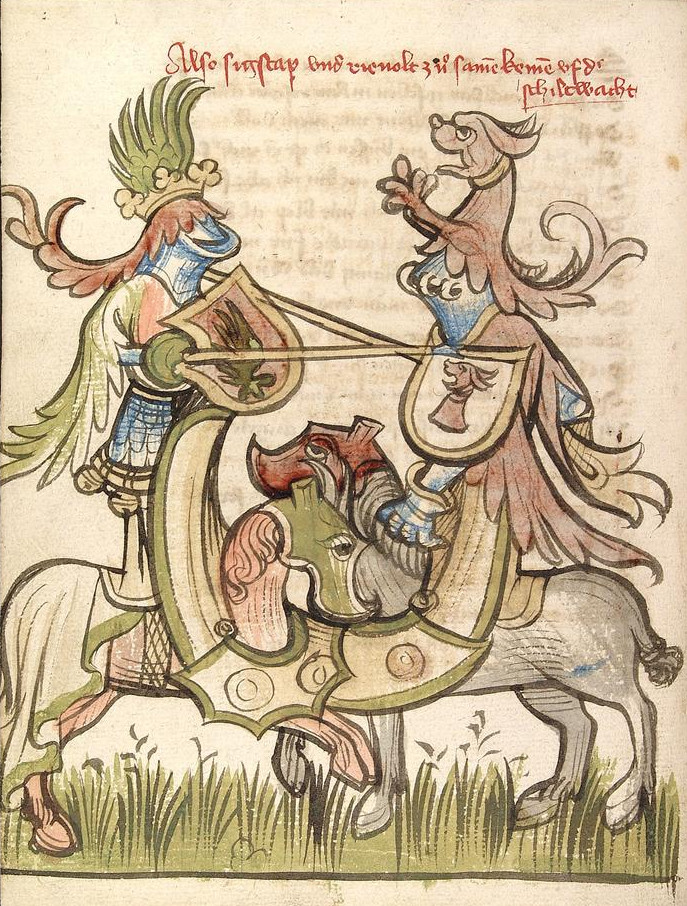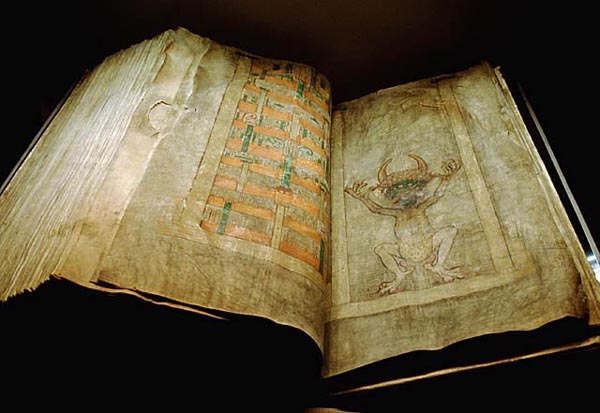|
Destrier
Mounted on a destrier, Richard Marshal unseats an opponent during a skirmish. The destrier is the best-known war horse of the Middle Ages. It carried knights in battles, tournaments, and jousts. It was described by contemporary sources as the ''Great Horse'', due to its significance. While highly prized by knights and men-at-arms, the destrier was not very common. Most knights and mounted men-at-arms rode other war horses, such as coursers and rounceys. Etymology The word is first attested in Middle English around 1330, as ''destrer''. It was borrowed into Middle English from Anglo-Norman ''destrer'', whose Old French counterpart was ''destrier'' (from which the Modern English spelling derives). The word is also found in medieval Provençal (as ''destrier'') and Italian (as ''destriere'', ''destriero''). These forms themselves derived from the Vulgar Latin ''equus dextrarius'', meaning "right-sided horse" (from ''dextra'', "right hand", the same root as ''dextrous'' ... [...More Info...] [...Related Items...] OR: [Wikipedia] [Google] [Baidu] |
Draft Horse
A draft horse (US), draught horse (UK) or dray horse (from the Old English ''dragan'' meaning "to draw or haul"; compare Dutch ''dragen'' and German ''tragen'' meaning "to carry" and Danish ''drage'' meaning "to draw" or "to fare"), less often called a carthorse, work horse or heavy horse, is a large horse bred to be a working animal doing hard tasks such as plowing and other farm labor. There are a number of breeds, with varying characteristics, but all share common traits of strength, patience, and a docile temperament which made them indispensable to generations of pre-industrial farmers. Draft horses and draft crossbreds are versatile breeds used today for a multitude of purposes, including farming, draft horse showing, logging, recreation, and other uses. They are also commonly used for crossbreeding, especially to light riding breeds such as the Thoroughbred, for the purpose of creating sport horses of warmblood type. While most draft horses are used for driving, ... [...More Info...] [...Related Items...] OR: [Wikipedia] [Google] [Baidu] |
Barding
Barding (also spelled ''bard'' or ''barb'') is body armour for war horses. The practice of armoring horses was first extensively developed in antiquity in the eastern kingdoms of Parthia and Pahlava. After the conquests of Alexander the Great it likely made its way into European military practices via the Seleucid Empire and later Byzantine Empire. Though its historical roots lie in antiquity in the regions of what was once the Persian Empire, barded horses have become a symbol of the late European Middle Ages chivalry and the era of knights. During the Late Middle Ages as armour protection for knights became more effective, their mounts became targets. This vulnerability was exploited by the Scots at the Battle of Bannockburn in the 14th century, when horses were killed by the infantry, and by the English at the Battle of Crécy in the same century where long-bowmen shot horses and the then dismounted French knights were killed by heavy infantry. Barding developed as a ... [...More Info...] [...Related Items...] OR: [Wikipedia] [Google] [Baidu] |
List Of Horse Breeds
This article is a list of horse and pony breeds with articles on Wikipedia, and also includes terms for types of horse that are not necessarily standardized breeds but are often labeled as breeds. While there is no scientifically accepted definition of the term "breed",The state of the world's animal genetic resources for food and agriculture. Barbara Rischkowsky and Dafydd Pilling. Commission on Genetic Resources for Food and Agriculture. 2007 a breed is generally defined as having distinct true-breeding characteristics over a number of generations. Its members may be called " purebred". In most cases, bloodlines of horse breeds are recorded with a breed registry. The concept is somewhat flexible in horses, as open stud books are created for recording pedigrees of horse breeds that are not yet fully true-breeding. Registries also are considered the authority as to whether a given breed is listed as a "horse" or a "pony". There are also a number of " color breed", sport h ... [...More Info...] [...Related Items...] OR: [Wikipedia] [Google] [Baidu] |
Man-at-arms
A man-at-arms was a soldier of the High Medieval to Renaissance periods who was typically well-versed in the use of arms and served as a fully-armoured heavy cavalryman. A man-at-arms could be a knight, or other nobleman, a member of a knight's or nobleman's retinue, or a mercenary in a company serving under a captain. Such men could serve for pay or through a feudal obligation. The terms ''knight'' and ''man-at-arms'' are often used interchangeably, but while all knights equipped for war were men-at-arms, not all men-at-arms were knights. Terminology Though in English the term man-at-arms is a fairly straightforward rendering of the French ''homme d'armes'', in the Middle Ages, there were numerous terms for this type of soldier, referring to the type of arms he would be expected to provide: In France, he might be known as a '' lance'' or '' glaive'', while in Germany, ''Spieß'', ''Helm'' or ''Gleve'', and in various places, a '' bascinet''. In Italy, the term '' ba ... [...More Info...] [...Related Items...] OR: [Wikipedia] [Google] [Baidu] |
Joust
Jousting is a martial game or hastilude between two horse riders wielding lances with blunted tips, often as part of a tournament. The primary aim was to replicate a clash of heavy cavalry, with each participant trying to strike the opponent while riding towards him at high speed, breaking the lance on the opponent's shield or jousting armour if possible, or unhorsing him. The joust became an iconic characteristic of the knight in Romantic medievalism. The participants experience close to three and a quarter times their body weight in G-forces when the lances collide with their armour. The term is derived from Old French , ultimately from Latin "to approach, to meet". The word was loaned into Middle English around 1300, when jousting was a very popular sport among the Anglo-Norman knighthood. The synonym tilt (as in tilting at windmills) dates . Jousting is based on the military use of the lance by heavy cavalry. It transformed into a specialized sport during the Late M ... [...More Info...] [...Related Items...] OR: [Wikipedia] [Google] [Baidu] |
Knight
A knight is a person granted an honorary title of knighthood by a head of state (including the Pope) or representative for service to the monarch, the church or the country, especially in a military capacity. Knighthood finds origins in the Greek '' hippeis'' and '' hoplite'' (ἱππεῖς) and Roman ''eques'' and '' centurion'' of classical antiquity. In the Early Middle Ages in Europe, knighthood was conferred upon mounted warriors. During the High Middle Ages, knighthood was considered a class of lower nobility. By the Late Middle Ages, the rank had become associated with the ideals of chivalry, a code of conduct for the perfect courtly Christian warrior. Often, a knight was a vassal who served as an elite fighter or a bodyguard for a lord, with payment in the form of land holdings. The lords trusted the knights, who were skilled in battle on horseback. Knighthood in the Middle Ages was closely linked with horsemanship (and especially the joust) from its origins ... [...More Info...] [...Related Items...] OR: [Wikipedia] [Google] [Baidu] |
Codex Manesse 052r Walther Von Klingen (detail 2)
The codex (plural codices ) was the historical ancestor of the modern book. Instead of being composed of sheets of paper, it used sheets of vellum, papyrus, or other materials. The term ''codex'' is often used for ancient manuscript books, with handwritten contents. A codex, much like the modern book, is bound by stacking the pages and securing one set of edges by a variety of methods over the centuries, yet in a form analogous to modern bookbinding. Modern books are divided into paperback or softback and those bound with stiff boards, called hardbacks. Elaborate historical bindings are called treasure bindings. At least in the Western world, the main alternative to the paged codex format for a long document was the continuous scroll, which was the dominant form of document in the ancient world. Some codices are continuously folded like a concertina, in particular the Maya codices and Aztec codices, which are actually long sheets of paper or animal skin folded into pages. The ... [...More Info...] [...Related Items...] OR: [Wikipedia] [Google] [Baidu] |
Horse Gait
Horses can use various gaits (patterns of leg movement) during locomotion across solid ground, either naturally or as a result of specialized training by humans.Ensminger, M. E. ''Horses and Horsemanship'' 6th edition USA: Interstate Publishers 1990 pp. 65–66 Classification Gaits are typically categorized into two groups: the "natural" gaits that most horses will use without special training, and the " ambling" gaits that are various smooth-riding four-beat footfall patterns that may appear naturally in some individuals. Special training is often required before a horse will perform an ambling gait in response to a rider's command. Another system of classification that applies to quadrupeds uses three categories: walking and ambling gaits, running or trotting gaits, and leaping gaits.Tristan David Martin Roberts (1995) ''Understanding Balance: The Mechanics of Posture and Locomotion'', Nelson Thornes, The British Horse Society Dressage Rules require competitors to pe ... [...More Info...] [...Related Items...] OR: [Wikipedia] [Google] [Baidu] |
Convex
Convex or convexity may refer to: Science and technology * Convex lens, in optics Mathematics * Convex set, containing the whole line segment that joins points ** Convex polygon, a polygon which encloses a convex set of points ** Convex polytope, a polytope with a convex set of points ** Convex metric space, a generalization of the convexity notion in abstract metric spaces * Convex function, when the line segment between any two points on the graph of the function lies above or on the graph * Convex conjugate, of a function * Convexity (algebraic geometry), a restrictive technical condition for algebraic varieties Algebraic varieties are the central objects of study in algebraic geometry, a sub-field of mathematics. Classically, an algebraic variety is defined as the set of solutions of a system of polynomial equations over the real or complex number ... originally introduced to analyze Kontsevich moduli spaces Economics and finance * Convexity (finance), second ... [...More Info...] [...Related Items...] OR: [Wikipedia] [Google] [Baidu] |
Packhorse
A packhorse, pack horse, or sumpter refers to a horse, mule, donkey, or pony used to carry goods on its back, usually in sidebags or panniers. Typically packhorses are used to cross difficult terrain, where the absence of roads prevents the use of wheeled vehicles. Use of packhorses dates from the neolithic period to the present day. Today, westernized nations primarily use packhorses for recreational pursuits, but they are still an important part of everyday transportation of goods throughout much of the developing world and have some military uses in rugged regions. History Packhorses have been used since the earliest period of domestication of the horse. They were invaluable throughout antiquity, through the Middle Ages, and into modern times where roads are nonexistent or poorly maintained. Historic use in England Packhorses were heavily used to transport goods and minerals in England from medieval times until the construction of the first turnpike roads and canals in the ... [...More Info...] [...Related Items...] OR: [Wikipedia] [Google] [Baidu] |
Sumpter Horse
A pack animal, also known as a sumpter animal or beast of burden, is an individual or type of working animal used by humans as means of transporting materials by attaching them so their weight bears on the animal's back, in contrast to draft animals which pull loads but do not carry them. Traditional pack animals are diverse including camels, goats, yaks, reindeer, water buffaloes, and llamas as well as the more familiar pack animals like dogs, horses, donkeys, and mules. Nomenclature The term ''pack animal'' is traditionally used in contrast to ''draft animal'', which is a working animal that typically pulls a load behind itself (such as a plow, a cart, a sled or a heavy log) rather than carrying cargo directly on its back. For instance, sled dogs pull loads but do not normally carry them, while working elephants have been used for centuries to haul logs out of forests. The term ''pack animal'' can also refer to animals which naturally live and hunt in packs in the wild, such ... [...More Info...] [...Related Items...] OR: [Wikipedia] [Google] [Baidu] |








